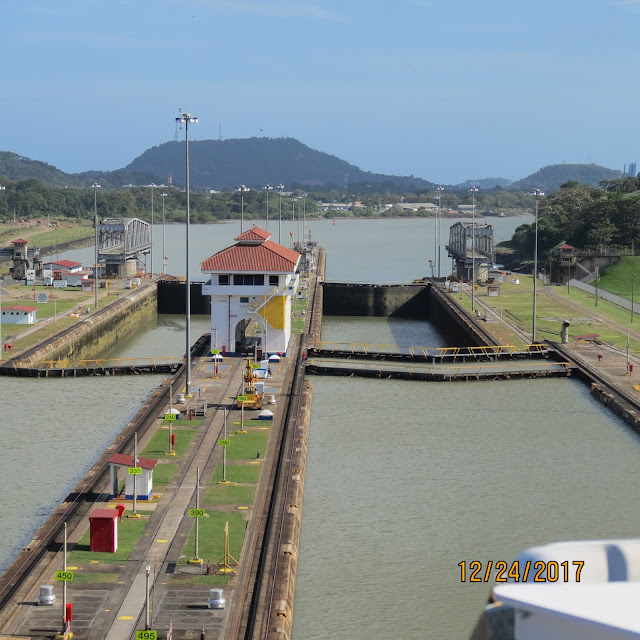December 24, 2017. Panama Canal is forty-eight miles long. Very cool experience being on a ship passing through the Panama Canal. The canal includes natural harbors (Limon Bay), Gaton Locks (three stage flight to 87 ft above sea level), artificial lakes (Gatun Lake), natural waterway (Chargres River), single state lock (Pedro Miquel Lock descend 31 ft), artificial lake (Miraflores Lake), two-stage lock (Miriflores Locks), and Balboa Harbor. The ship passed through three sets of locks that lifted our ship eighty-five feet above sea level and then lowered our ship back to sea level on the other side in order to enter the Pacific Ocean. Our ship powered itself through the locks and was held straight in the lock by electric engines called mules. Happy to see one of the mules operated by a woman. It takes about eleven hours to pass through the canal. A ship that is the maximum size allowed to pass through the canal is called Panamax.
Ships must pay cash or arrange for bank draft. It costs extra to schedule a time for passing through the canal. Some ships just show up and wait their turn or wait for the money to be paid by their company. Panama makes a lot of money, but also invests about 3/4 of that money on maintenance of the canal. I believe it was $250,000 for our ship to go through the canal. The lowest toll paid was thirty-six cents by American Richard Halliburton who swam the canal in 1928.
Panamanian pilots boarded our ship to guide our boat through the locks. Notice the van crossing the bridge after the ship ahead of us was lifted in the lock. The bridge the van was on retracted into the frame and that ship moved on. Then it was our turn to be lifted. Also, notice the ship coming the other way on the left side of the picture.

The steam engine/mule uses ropes to hold our ship straight in the lock.

Mules being hooked up with ropes to our ship.

Tug that brought the Panamanian Pilots.

These men in rowboats help transfer the ropes from our ship to the men that will connect them to the mules.

Mule that was being operated by a woman.

Water is going down lowering our ship to sea level on the Pacific end of the Panama Canal.
 |
| Notice the people walking on the bridge of the first gate. |
Ships must pay cash or arrange for bank draft. It costs more to schedule a time for passing through the canal. Some ships just show up and wait their turn or wait for the money to be paid by their company. Panama makes a lot of money, but also invests about 3/4 of that money on maintenance of the canal.
 |
| Notice the ship coming the other way on the left side of the picture. |
 |
| Tug central |
 |
| Not a lot of room on this side. |
 |
| Cargo ship ahead of us and another ship coming the other way. |
 |
| Mule keeping us straight |
 |
| Panama City in the distance. |
 |
| Lowering to the Pacific Ocean. Notice the ladders on the side. |
 |
| Lowering to Pacific Ocean |
 |
| Lowering to Pacific Ocean |
Someday I may redo this blog post in order...
 These men in rowboats help transfer the ropes from our ship to the men that will connect them to the mules.
These men in rowboats help transfer the ropes from our ship to the men that will connect them to the mules. 

























That is so cool! Now I want to go through!
ReplyDelete